The Huayna Picchu hike in Peru can be a bit challenging and scary at times, but it’s hands down one of the best things to do in Machu Picchu, the legendary lost city of the Incas.
This is a bucket list hiking trail that takes you to the top of Wayna Picchu (the iconic mountain behind Machu Picchu), and at the summit you get to see original Inca buildings and epic panoramic views.
Don’t be too scared by the nickname — even though these have been dubbed the Machu Picchu ‘Stairs of Death’ (for their steepness and narrowness), there have been very few accidents and deaths here over the years, and overall it’s quite safe as long as you don’t goof off.
This travel guide will explain how to get to Huayna Picchu mountain, how to safely hike the Huayna Picchu ‘Stairs of Death’, and everything else you need to know before you go!
Huayna Picchu: Quick Facts
- Distance: 4 kilometers (2.5 mi) round trip
- Elevation Gain: 305 meters (1,000 ft)
- Top Elevation: 2,693 meters (8,835 ft)
- Duration: 2 – 3 hours round trip
- Difficulty: Moderate / Hard

The Machu Picchu ‘Stairs of Death’
What Does Huayna Picchu Mean?
The name ‘Wayna Picchu’ comes from the Quechua language, meaning ‘young mountain’ (‘wayna’ is young and ‘picchu’ is mountain).
‘Huayna Picchu’ is an alternative spelling for the same name, and it’s more commonly used on the internet nowadays.
Where Is Huayna Picchu?
Huayna Picchu is the mountain behind the famous Machu Picchu citadel in Cusco, Peru, which was home to the Incas in the 15th century.
This mountain is sometimes confused with Montana Machu Picchu, which is another nearby peak you can hike, but Huayna is actually the iconic mountain you see directly behind the ruins when you first enter Machu Picchu and stand at the famous viewpoint.
To reach Huayna Picchu and start the hike, you first have to walk through the Machu Picchu ruins, since the trail starts on the north side of the park.

Huayna Picchu is the mountain behind Machu Picchu
Huayna Picchu Hike: What To Expect
The Huayna Picchu hike is a scenic trail that takes you up a jungle-covered mountainside on stone stairways built by the medieval Inca empire.
It’s a bit challenging, but entirely non-technical, and fit hikers can reach the top of the mountain in 1 hour or less. The steepest staircases are at the end of the hike, near the summit.
In spite of its difficulty, this trail is in high demand and it’s limited to only 400 hikers per day, so you often have to book several months in advance to get a spot.
The details below will explain each part of the Huayna Picchu hike and what to expect. It’s an unforgettable experience!

The mountain
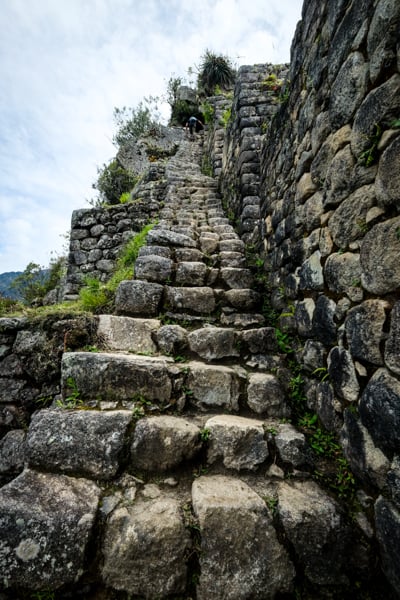
The stairs
• Trail Beginning
The good scenery starts almost immediately on the Huayna Picchu hike.
Right away, you get clear views of Putucusi mountain and the Urubamba river, with a row of dramatic green peaks in the distance.
From here on, there is really only one path leading to the top of Huayna Picchu, and plenty of other international hikers headed in the same direction, so you can’t get lost.
The rest of the hike is an uphill trudge on Inca stone stairways, although many of the switchbacks have enough plant cover to give you some shade from the sun.
These stone steps are not in the greatest condition, but they still make the hike a bit more manageable than stairless hikes where you’re walking on dirt or mud.

Instant views of Putucusi mountain and the Urubamba river.
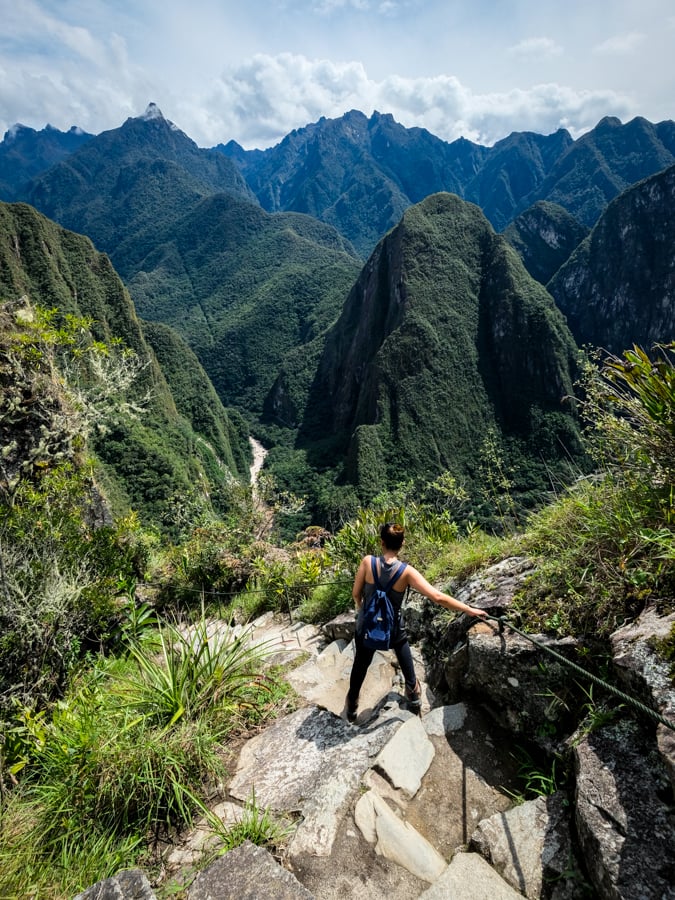
Starting the Wayna Picchu hike
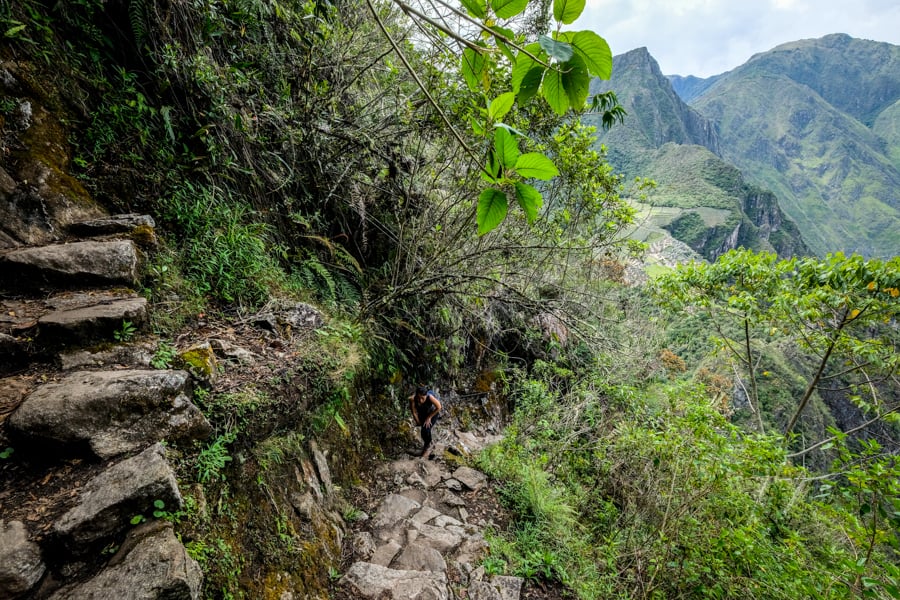
Entering the brush
• Inca Buildings
After about 20-30 minutes of hiking, you’ll get your first views of the Machu Picchu citadel behind you in the distance, reminding you how high you already are!
At this point, the stairway becomes a lot more steep and narrow, so there’s a steel cable you can hold for extra balance. The stone steps are still secure enough, but their small size makes them a bit awkward.
This is also where you’ll encounter your first Inca buildings and terraces on the path ahead, which you’ll traverse on your way to the summit of Huayna Picchu mountain.
According to the locals, these structures were inhabited by the priests of Machu Picchu.
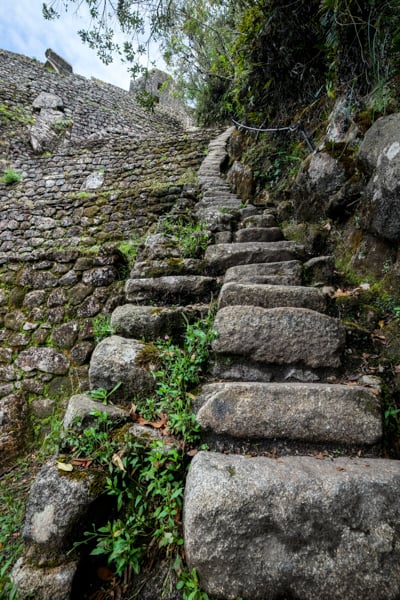
Stairs
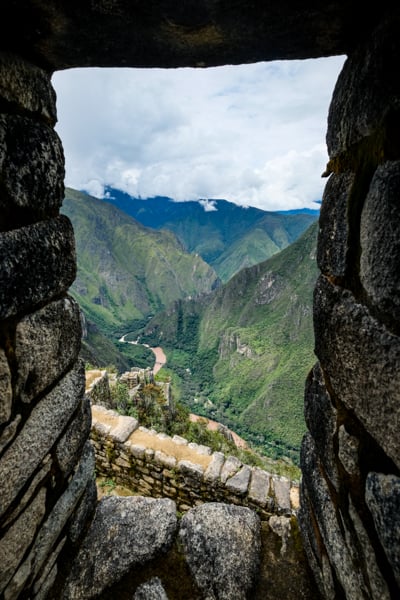
Windows
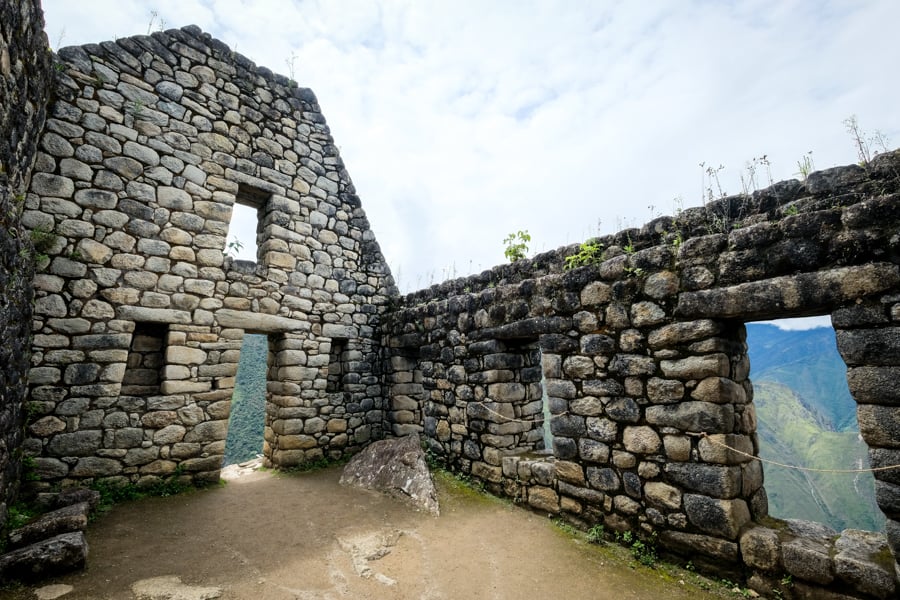
Inca buildings
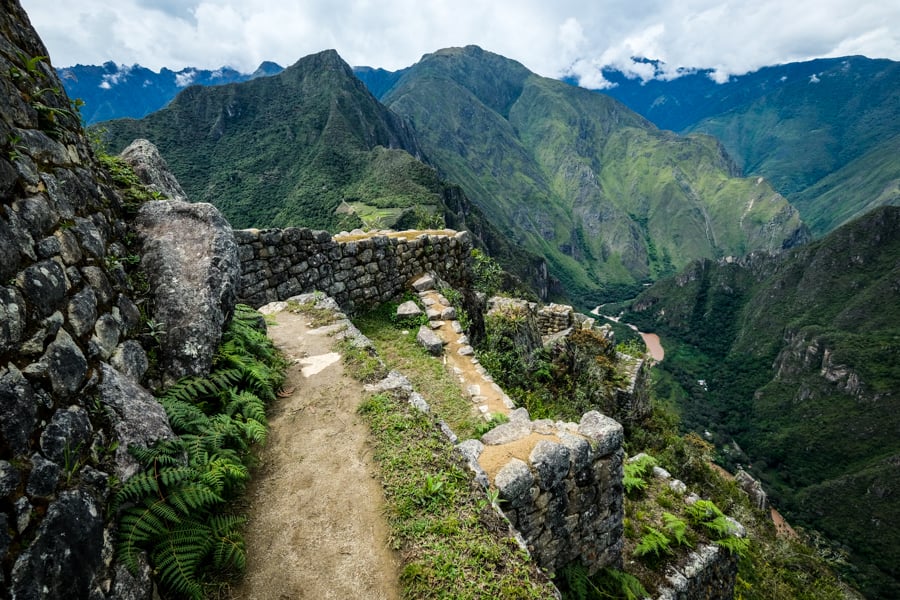
Near the top
Most of these Inca buildings are open to the public, so you can walk around in them and take a breather before continuing the Huayna Picchu hike.
A few of the buildings have windows with stunning views of the Andes mountains. What would it have been like to live up here? Can you imagine?
We wanted to stay longer and spend hours exploring these ruins, but we were too excited to see the grand finale of this hike — the Huayna Picchu ‘Stairs of Death’ — and the final summit!
• Machu Picchu Stairs of Death
It’s time for the Machu Picchu ‘Stairs of Death’! This epic stone staircase is your final challenge before reaching the summit of Huayna Picchu mountain.
In spite of the scary name, you’re really not in imminent danger here and the path is plenty wide. Don’t get me wrong though, the views are dizzying!
There are steep drop-offs, but they’re not as close as they seem. Even if you somehow fell off the stairway, you would land on one of the grassy terraces with room to spare.
It’s not known how many steps there are in total, but many of them are irregularly shaped and quite stubby, so you may not always be able to fit your whole foot on them.
The traffic on this stairway only goes in one direction (up), and there are several places to step off the trail and let other hikers pass, so you don’t need to rush through it.
The Huayna Picchu ‘death stairs’ were my favorite part of the whole hike. We must have spent the better part of an hour here, just soaking up the views and trying to take pictures that capture the vertigo-inducing scene.
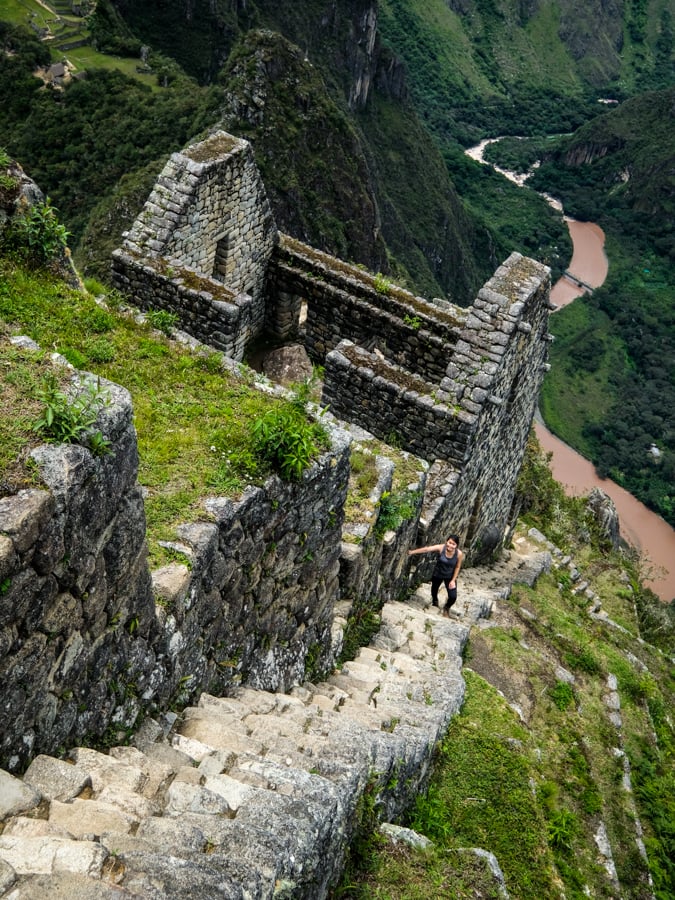
Climbing the Huayna Picchu ‘Stairs of Death’
• Huayna Picchu Summit
After walking a short distance past the last stone stairway, you’ll reach the summit of Huayna Picchu Mountain!
The Huayna Picchu altitude is 2,693 meters (8,835 ft), and you have spectacular views of Machu Picchu and the zigzag switchbacks of the bus road leading to the citadel.
You’re surrounded by the Andes mountains on all sides. You can even see Huchuy Picchu mountain (which looks tiny below), and the pointy peak of Montana Machu Picchu.
In my opinion, it’s one of the best views anywhere in Peru, and if you reach the top at a busy time you may have to wait in line here for pictures.
Be careful at the top of Huayna Picchu because, again, there are some steep drop-offs here if you aren’t careful. There is usually a ranger stationed at the top to make sure people aren’t doing anything dangerous.
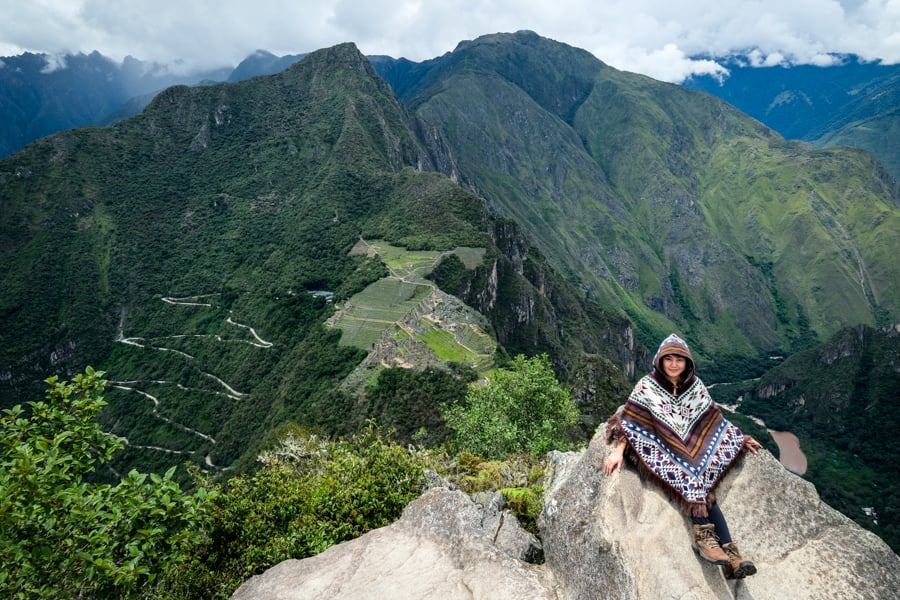
Summit views from Huayna Picchu mountain
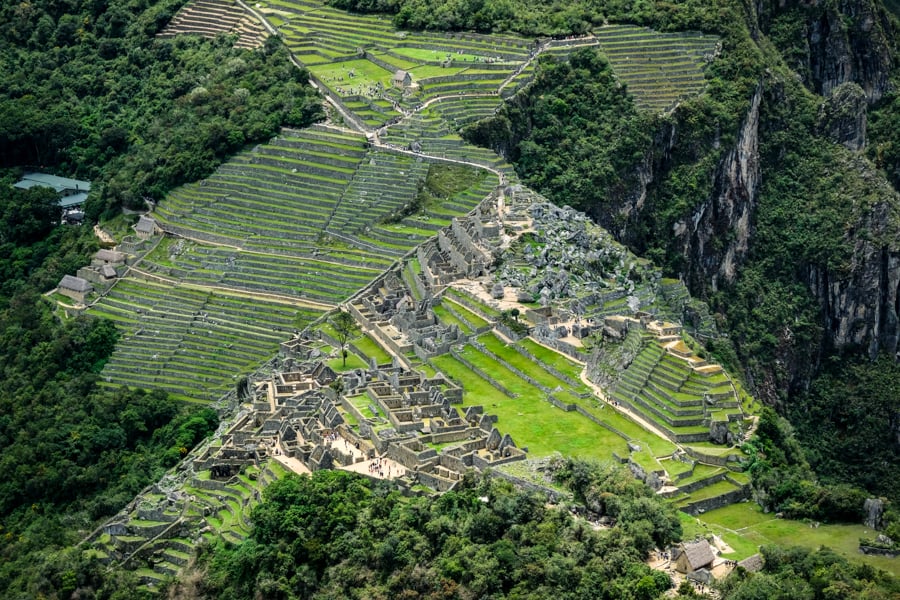
Machu Picchu citadel as seen from above (with a zoom lens).
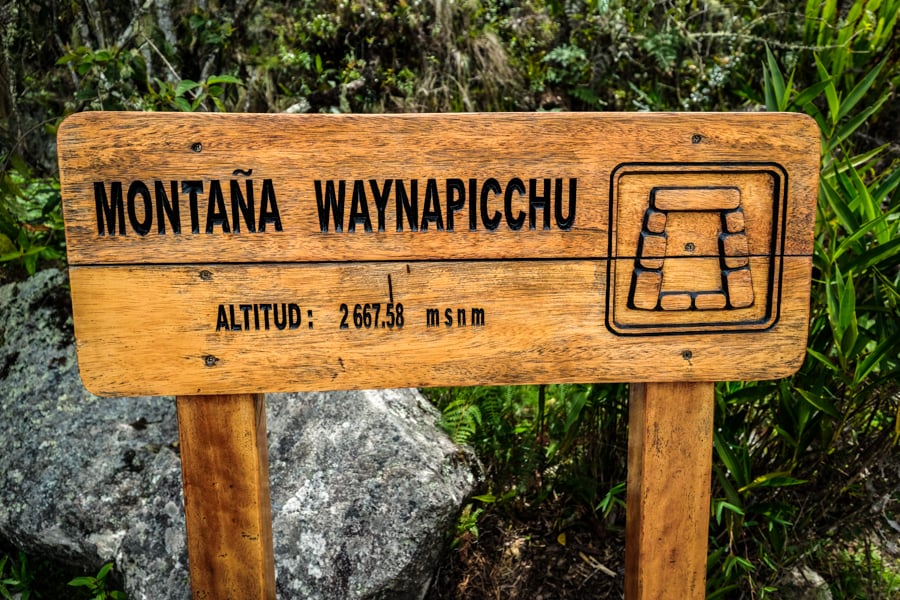
Summit sign
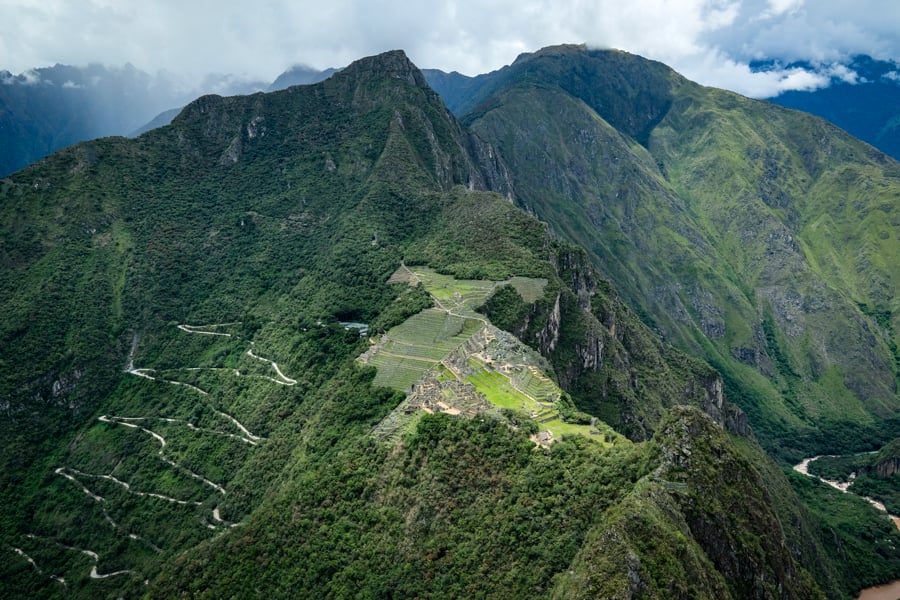
Machu Picchu in the distance
• Temple of the Moon
Shortly after reaching the summit of Huayna Picchu mountain, keep an eye out for a spur trail to go around the backside of the mountain.
This path leads to the Temple of the Moon (Huaca de la Luna), which is an ancient ceremonial temple inside of a cave that may have held mummies back in the day.
This fascinating cave temple is an optional detour from the main path at Huayna Picchu mountain, and it’s not always open to hikers, but it’s well worth seeing if you’re able.
If you plan to visit this side trail, budget an extra 2 hours of total hiking time at Wayna Picchu.
• The Tunnel
On the way down from the top of Huayna Picchu mountain, there’s a short, narrow tunnel you have to cross to get back to the main trail.
This passage is very small at the entrance, so you might have to remove your backpack and crawl just to get through it. It’s another neat little feature of the hike that we thought was really cool.
After passing this tunnel, the path loops back to the original trail and you can make your way down to the start of the Huayna Picchu hike.
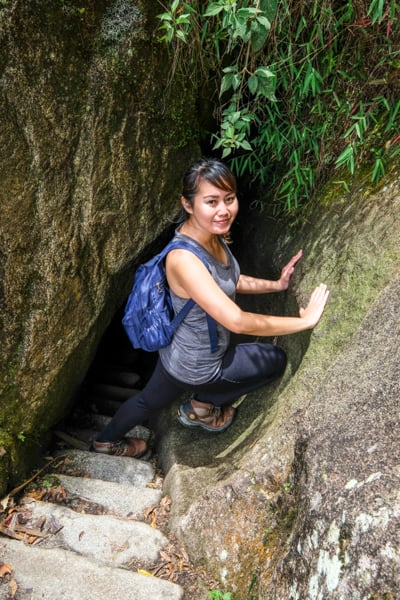
Outside
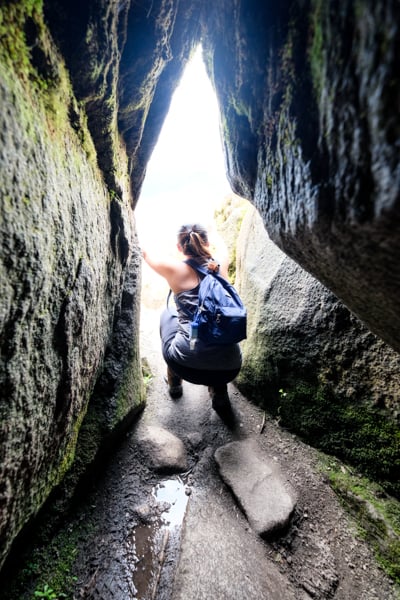
Inside
Huayna Picchu Difficulty
This hike is challenging, but it’s not extremely hard or dangerous. It’s like a stairmaster, not a via ferrata. We expected it to be harder based on things we’d read online.
The main difficulty at Huayna Picchu is the steepness of the stairs and also the altitude, which makes it harder to get your breath. However, if you’ve already spent a couple days acclimating in Peru, then the altitude shouldn’t be a big factor.
If you want to train for this hike, just climb lots and lots of stairs!
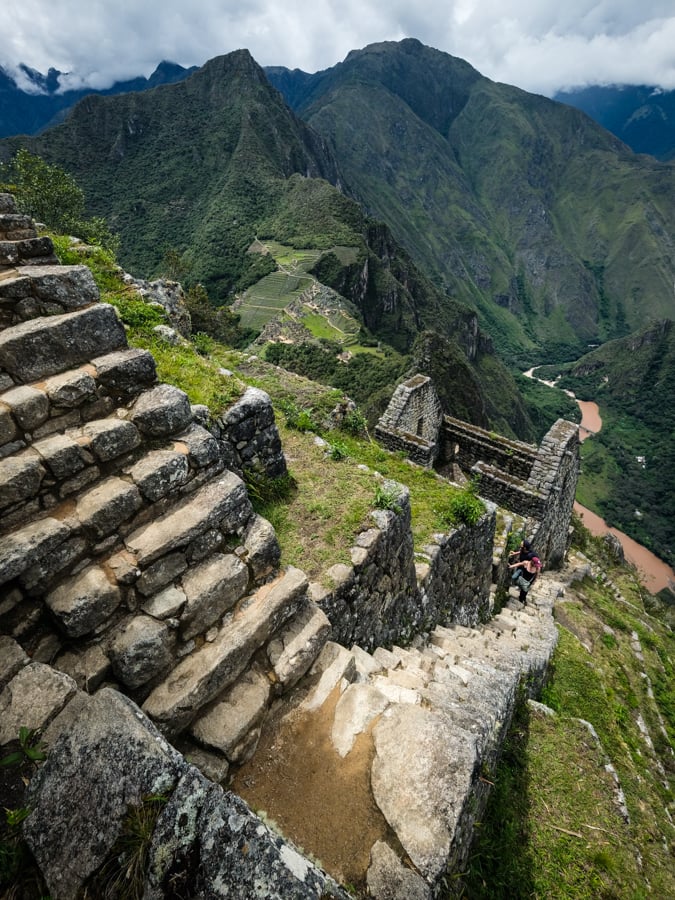
The Machu Picchu ‘Stairs of Death’
Is Huayna Picchu Safe?
Huayna Picchu is a very safe hike if you’re careful, although I wouldn’t recommend it for young kids, unfit older folks, or anyone who is not surefooted and comfortable with heights.
The safety has improved in recent years. In the past, the loop section near the summit was hiked in the opposite direction, meaning you’d walk down the Huayna Picchu ‘Stairs of Death’, instead of up. As you can imagine, this was scarier and more awkward than the current setup!
In any case, hundreds of people successfully hike the Huayna Picchu ‘death stairs’ every day, and accidents are very rare. You don’t need any technical skills to do it, just a good level of fitness.
I wouldn’t say hiking Huayna Picchu is for everyone, but if you enjoy adventure, photography, and a good adrenaline rush, then definitely add it to your Peru bucket list!
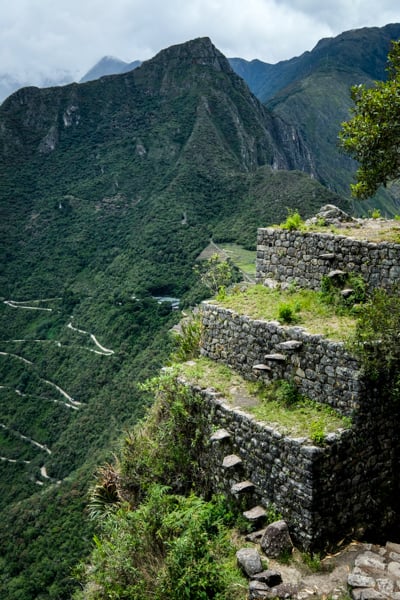
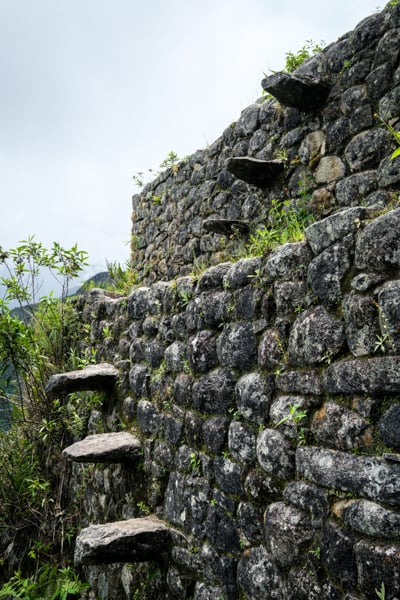
Wayna Picchu Accidents & Deaths
The internet is rife with exaggerated myths about the death rate at Wayna Picchu, but most of these stories and figures don’t seem to be accurate.
However, here are a few Wayna Picchu accidents that are confirmed and verifiable:
- In 1997, a 68-year-old American tourist fell and died near the top of the Huayna Picchu hike. (Source: UPI)
- In 2004, a Russian tourist died after being struck by lightning on the mountain. (Source: Washington Post)
- In 2009, a 66-year-old American tourist died of “massive internal injuries” after falling from “a mountain above Machu Picchu,” but it’s not clear if this was Wayna Picchu, the Inca Trail, or possibly Montana Machu Picchu. (Source: ABA Journal)
- In 2014, a Belgian tourist reportedly died on the Huayna Picchu hike, but no other details are known, so it’s anyone’s guess what may have happened. (Source: Washington Post)
- In 2016, a German tourist fell 200 meters and died while ‘jumping in the air’ trying to get stunt photos near the edge of a cliff. Again, it’s not known if this was at Wayna Picchu or Montana Machu Picchu. (Source: NY Daily News)
There have been many other deaths at Machu Picchu over the years, but if you dig into the details, most of these accidents happened on the Inca Trail or at the citadel itself, and the circumstances were out of the ordinary.
The main killers at Machu Picchu over the years have been heart attacks, falls, lightning strikes, rockfalls, and selfie accidents — seemingly in that order.
Any of these accidents are unfortunate, of course, but remember millions of people visit Machu Picchu every year, and there are usually zero deaths per year at both Machu and Huayna Picchu.
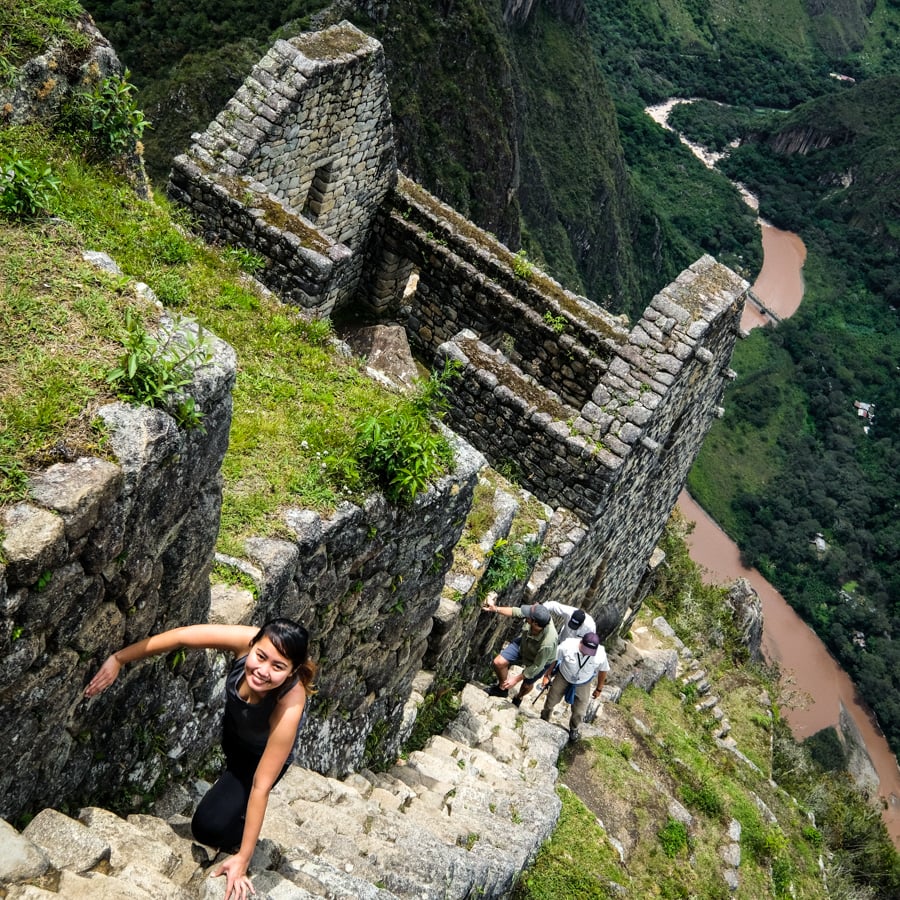
All smiles!
How To Safely Hike Huayna Picchu
So what are some ways you can stay safe and lessen your risks at Huayna Picchu?
Well, as you can see from the accounts mentioned above, you should at least try to give the mountain a bit of healthy respect. If there’s one thing that can make Huayna Picchu dangerous, it’s goofing off or trying to take selfie photos by the edge of a cliff.
You should also wear proper footwear, stay off of mountains in a thunderstorm, and don’t attempt hikes that are beyond your physical abilities.
If you’re still feeling unsure about Huayna Picchu, you also have the option of hiring a private tour guide for the hike, that way there’s someone experienced to explain everything for you as you go.
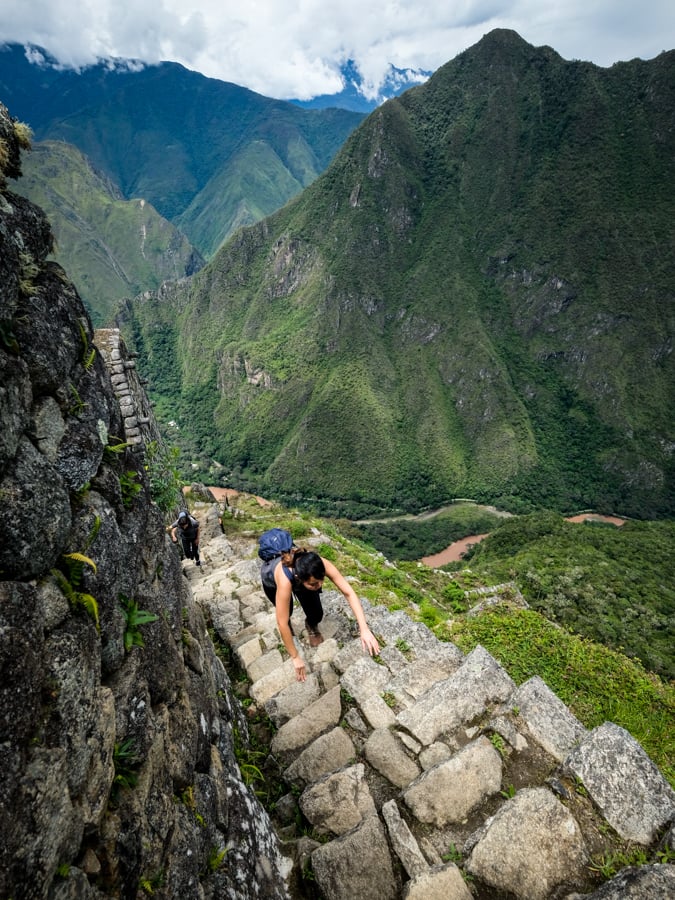
Scurrying up the Machu Picchu ‘Stairs of Death’
What To Bring
- Shoes. This trail is not a good one for flip flops. Hiking boots are best if you have them, but you’ll at least want shoes with good grip for Wayna Picchu.
- Water. Try to pack at least 1 liter of water per person. It’s important to stay hydrated at higher altitudes.
- Snacks. We brought some granola bars and shared them at the top of the mountain, after climbing the stairs.
- Sunscreen. The sun is another thing amplified by the altitude, so you’ll want sunscreen and a hat to avoid burns.
- Poncho. A raincoat is good to have, just in case. This is especially important if you go in the rainy season.
- Bug Spray. We didn’t use any bug repellant, and came away with a few bites, so it could be handy.
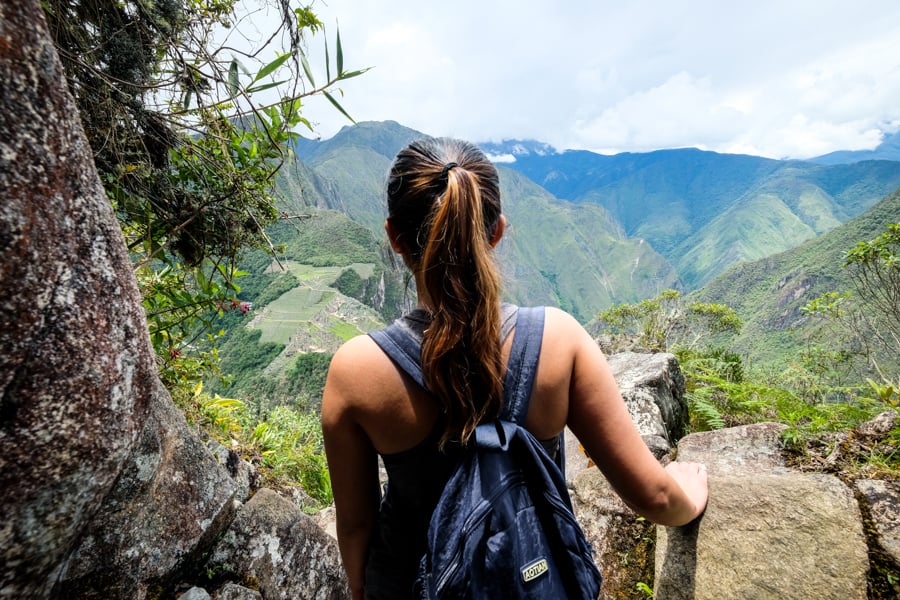
Exiting the cave
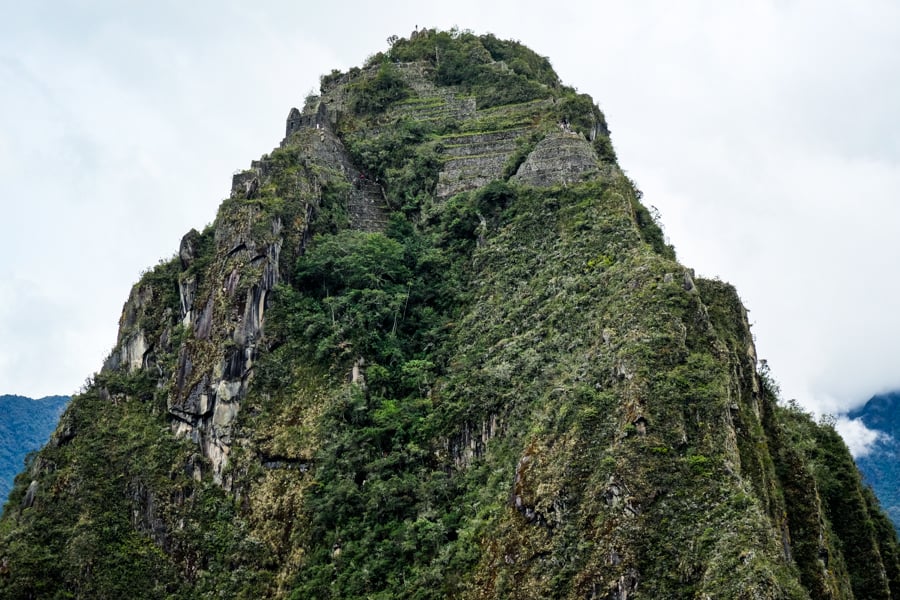
The peak of Huayna Picchu as seen from below. If you zoom in, you can see the tiny hikers.
Huayna Picchu Tickets: How To Get Them
A permit is required to hike Wayna Picchu, and only 400 permits are given out per day (200 during Covid), which keeps down congestion on the trail. These can only be bought online.
This restriction, combined with the trail’s wild popularity as a bucket list item, means you will probably have to book your tickets several months in advance if you want to do this hike, otherwise they sell out.
You can book your tickets on the official Machu Picchu ticket website (https://www.machupicchu.gob.pe), or on the GetYourGuide tour website. The official site is a bit cheaper, but it’s entirely in Spanish and the design is a confusing mess.
The biggest benefit of booking on GetYourGuide is that the tickets are 100% refundable if you change your mind before you go. The official Machu Picchu website staff, on the other hand, are often stingy with refunds in our experience. GYG is also a more convenient website that’s written in English, whereas the official site is currently Spanish only.
Both websites are reliable and you can use either to purchase your Wayna Picchu tickets. A local tour guide isn’t required for this hike, you just need tickets. However, you can always hire a guide at the entrance of Machu Picchu if you’d like, and after agreeing on a price, they’ll accompany you into the ruins, explain things, and take pictures for you.
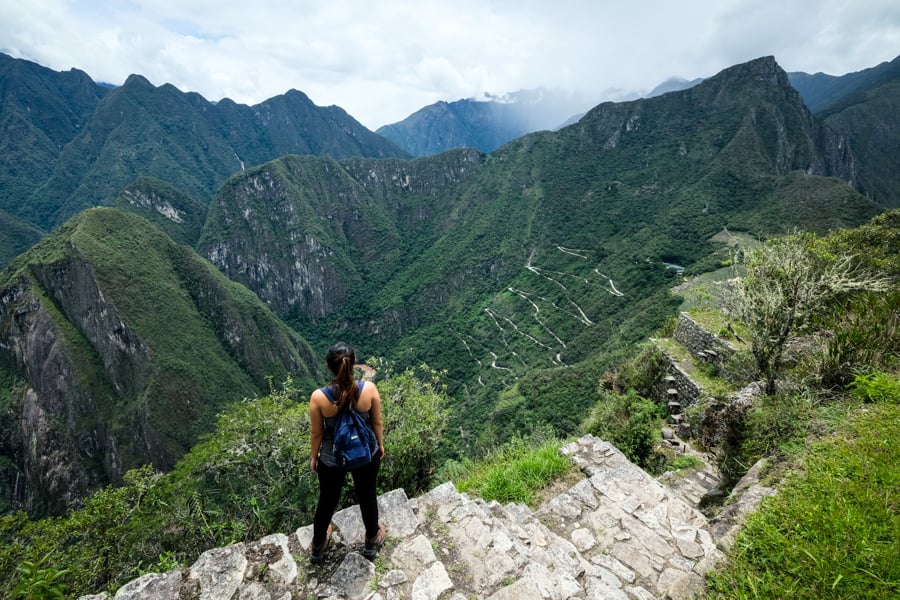
Green mountains in all directions
Hours & Fees
The whole Machu Picchu area is open 6:00 AM – 5:30 PM daily.
Stays are supposedly limited to a few hours, but the staff doesn’t enforce this, and as long as you aren’t causing a problem you can pretty much stay as long as you like.
For the Huayna Picchu hike, tickets are split up into four different entry times in order to reduce congestion on the trail. For each of these time slots, 100 tickets are available (400 total per day).
Choose a time slot that suits you, and keep in mind it only affects when you’re required to enter. Once you’re inside the control gate for Huayna Picchu, you can stay as long as you like!
The current adult ticket price for Huayna Picchu is 200 soles (~$52 USD) as of 2022, and that gives you entrance to the mountain and also Circuit 4 of the Machu Picchu ruins. Students and minors (ages 3-17) get a 50 percent discount.
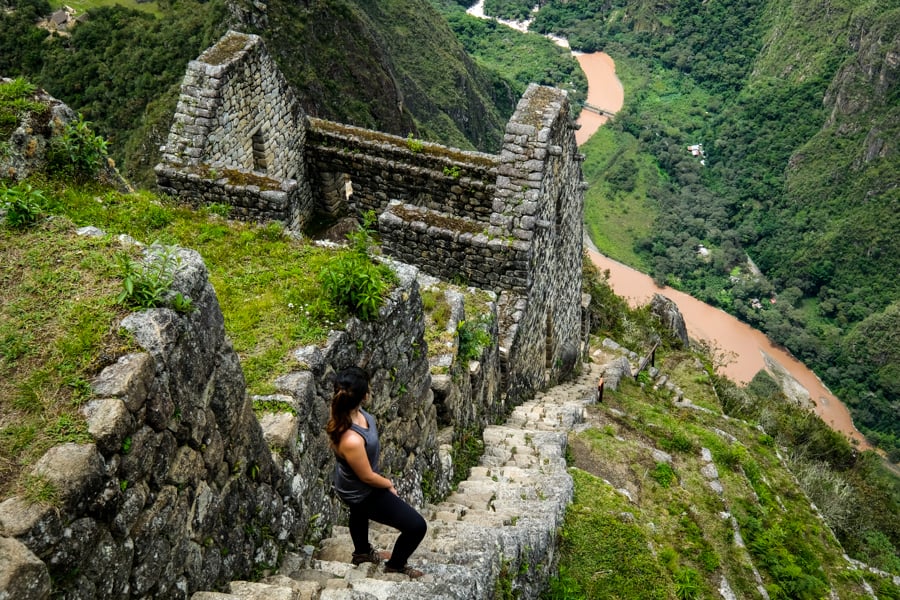
The Huayna Picchu ‘Stairs of Death’
Route Map
This route map shows how to get to Huayna Picchu from the main entrance of the Machu Picchu citadel. You can click on the picture to enlarge.
How To Get To Huayna Pichu Mountain
The hiking trail for Huayna Picchu is located on the north side of the Machu Picchu citadel, behind a control gate that you also pass to reach the Huchuy Picchu hike.
You can see the route map above for a general idea of where to go, but be prepared to ask the staff for directions, because even with a map it can be a bit tricky to find if you’re in a hurry.
Remember to be at the main Machu Picchu entrance gate at least 1 hour before the entry time that’s printed on your hiking ticket, because there may be lines at the entrance of the citadel, and it can also take 15-30 minutes to walk from the start of the citadel to the Huayna Picchu control gate.
This is important, because you risk losing your tickets if you’re late. The staff is very unforgiving and they won’t let you enter the control gate at Huayna Picchu if you’re even one minute later than the entry time printed on your hiking ticket (it’s a hassle, I know).
Shortly after you reach the control gate, you’ll be asked to sign your name in the guest list (before and after the hike) in case anyone happens to go missing on the mountain.
From here, the trail is well marked with a sign indicating which way to go for Huayna Picchu, which quickly splits off from the path to Huchuy Picchu. At this point, everything becomes straightforward.
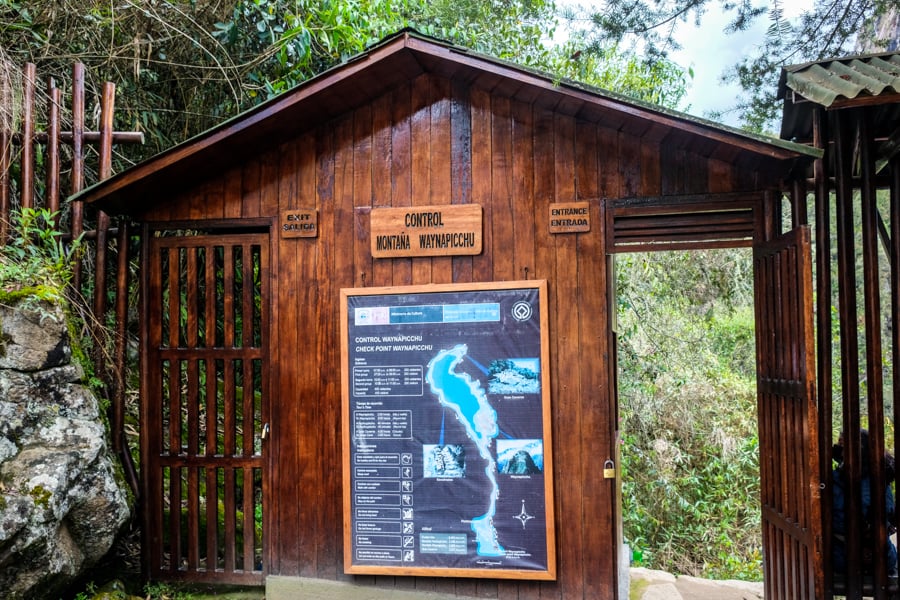
Entrance gate for Huayna Picchu and Huchuy Picchu
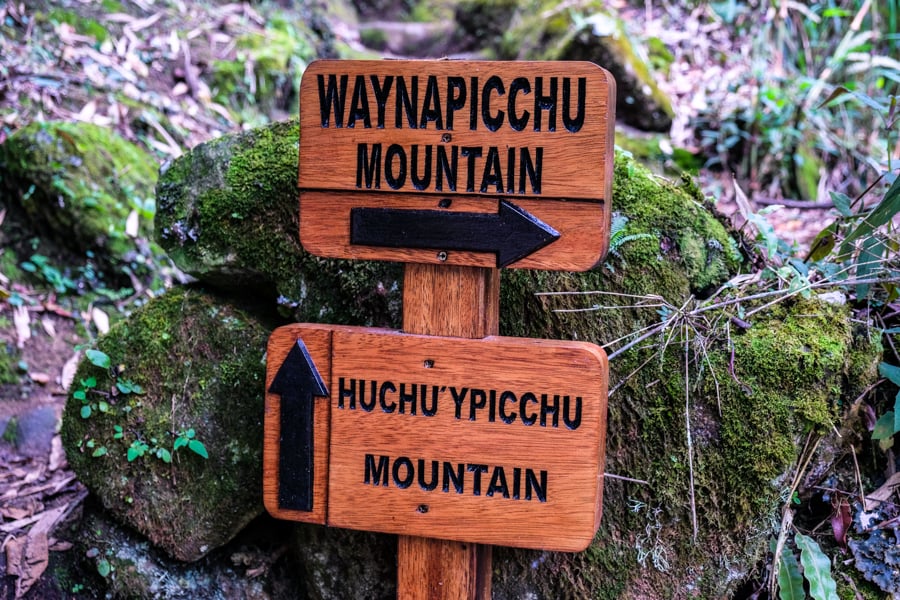
Wooden sign at the trail fork
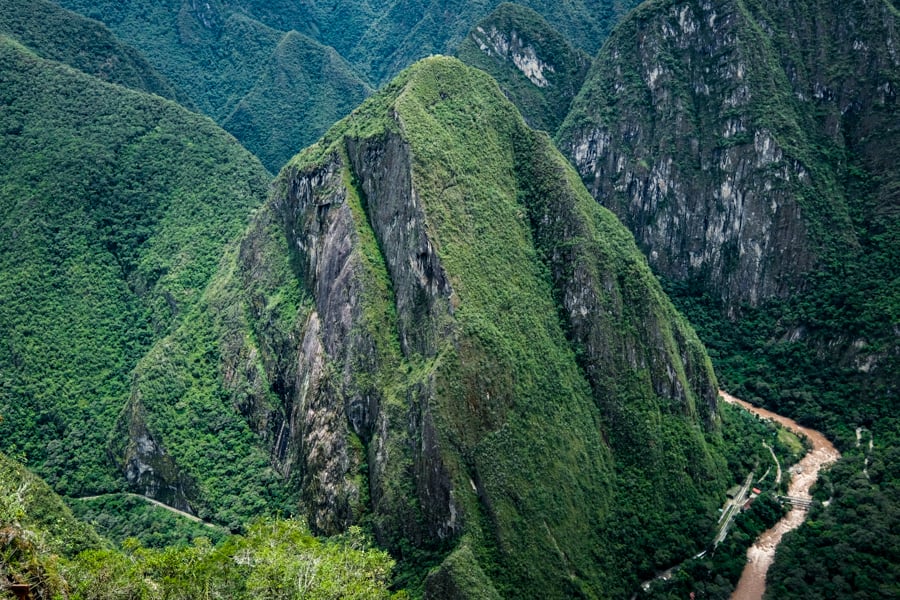
Putucusi Mountain
Is Wayna Picchu Worth It?
Yes, the Wayna Picchu hike is so worthwhile!
It’s an amazing combination of scenery, history, thrills, and challenge. We loved this hike and I hope I can do it again someday. It’s like something out of Indiana Jones.
Plus, it’s fun to look at the classic photos of Machu Picchu and know that you’ve hiked the mountain right behind it.
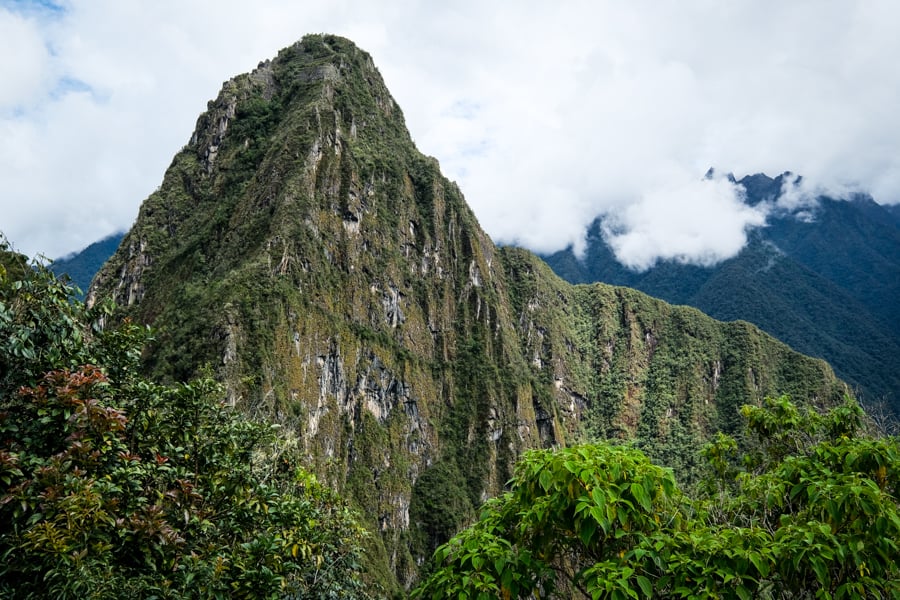
One last look at Huayna Picchu mountain before we said goodbye!
When To Hike Wayna Picchu
Generally the best time to do hikes at Machu Picchu is during Peru’s dry season, which runs from May to October. The days are more sunny during this time, and there’s a lot less rain.
With that said, I wouldn’t write off the rainy season completely. We did this hike and several others in January, and had fine weather. The rain usually comes in the afternoons or evenings, but bring a poncho just in case.
In my opinion, the best time of day to climb Huayna Picchu is in the late morning. This is usually when the morning mist clears, giving you better views of the Andes mountains.
Best Machu Picchu Tours
If you want a prearranged tour for your visit to Machu Picchu, there are plenty of good online options.
GetYourGuide has full day tours of Machu Picchu starting from Cusco (private or with a group), as well as spectacular mountain hikes like Huayna Picchu, which requires an advance booking anyway since it's so popular.
We used this company for lots of tours and activities in Peru, and they're great. Highly recommended!
Machu Picchu Hike List
This hike is one of many at the Machu Picchu citadel in Peru.
- Machu Picchu Mountain: The highest mountain in the area, and the toughest to climb. The summit elevation is 3,082 meters (10,111 ft).
- Huchuy Picchu Mountain: A short, relatively easy hike to the top of a small mountain behind the citadel.
- Huayna Picchu Mountain: That’s this one. The most famous and spectacular hike at Machu Picchu. The summit elevation is 2,693 meters (8,835 ft), but to reach the top you have to climb the so-called ‘Machu Picchu Stairs of Death.’
- Inca Sun Gate: Also known as Inti Punku, this is a moderate hike to a scenic viewpoint at an Inca gate, which originally served as the main entrance to Machu Picchu.
- Inca Bridge: This short hike is an easy little detour to see a bridge that once served as the secret back entrance to Machu Picchu.
- Inca Trail: If you really want to make a grand entrance to Machu Picchu, consider the Inca Trail. This is an iconic multi-day hike in Peru that takes 1-7 days (depending on where you start), and it ends at the Machu Picchu citadel. Much of the trail is on roads that were originally built by the Incas.
- Putucusi Mountain: A dangerous, unmaintained ladder trail to the top of Putucusi, which is an arrowhead-shaped mountain you can see across the river from Machu Picchu. Unfortunately the main ladder for this hike was destroyed by bad weather more than 4 years ago, so it’s very rarely climbed now. Hopefully the path will be fixed someday.
Machu Picchu Hotels
More Things To Do In Machu Picchu
Thanks for looking! I hope you enjoyed this travel guide for the Peru ‘stairs of death’ on Huayna Picchu mountain.
Don’t forget to check out my complete list of the top 10 best things to do in Machu Picchu Peru!
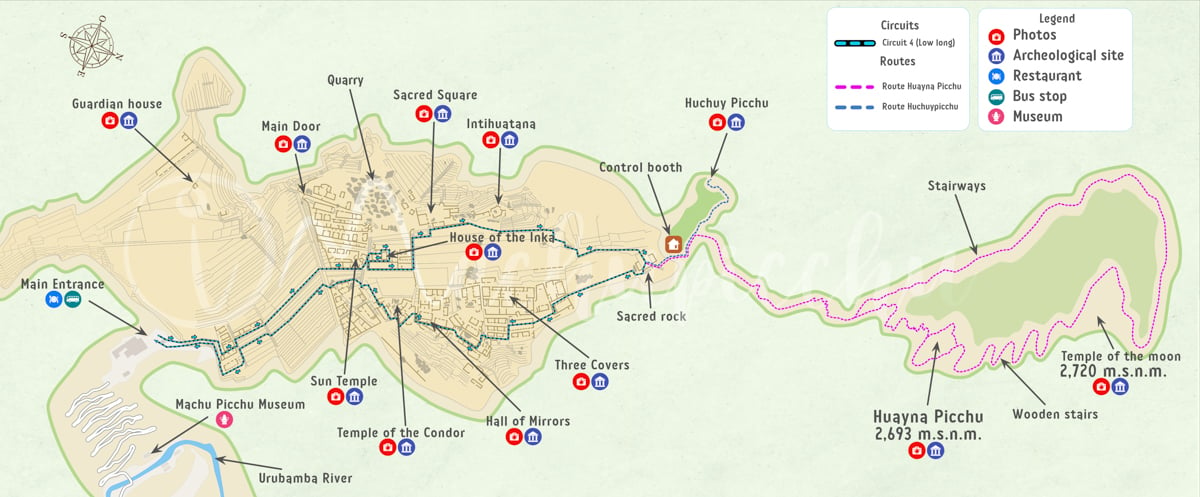
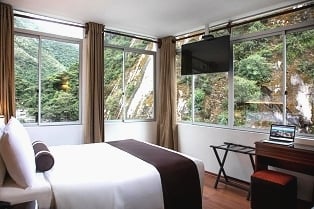



10 comments
I climbed Huayna Picchu back in 1990 and it was bare bones as far as any cables, ropes or anything else to help you up the mountain. The one rope was frayed, but I had to get to the top. Amazing view! I actually slept in Machu Picchu one night, (illegally) but was worth it! Kinda creepy though.
That’s great! I’d love to sleep in Machu Picchu. I’m sure that was an amazing experience.
Did the route of descent recently change? In youtube videos and other blogs (2018 and earlier) it’s like as if the descent looks a lot scarier than written in this blog. We are doing the Huayna Picchu climb next week and I can’t help but panic every now and then because of the stories and videos of the descent. Was is really much scarier than the ascent?
Love this blog! Very helpfull!
Hi Chloe! Yes, in the past, the loop section near the summit was hiked in the opposite direction, meaning you’d walk down the steep stairs when you descend. But nowadays, you hike up the steep stairs. It’s a bit easier and less scary than it was before. Some of the videos and pictures on the internet also exaggerate the steepness, so it looks worse than it actually is. It’s really not too bad. I’m sure you’ll have a great hike. Good luck!
I hiked Huyana Picchu in 1993 (as a 27 year old) and you would go through the tunnel on your way up and the stairs of death on the way down. I discovered I had a fear of heights when I came out of that tunnel and made my way to the summit. I was ok for the first minute or so and then panic set in as I was looking around and down. I had a lot of trouble getting onto the stairs when it was time to leave, it was similar to getting on a ladder going down. We were stuck up there for a couple of hours until I was coaxed and convinced that I had to get on those stairs. Going the opposite way, taking the stairs of death up and the tunnel down seems so much easier. I had no idea they were referred to as the stairs of death until recently. Also, there were no crowds, very few people even hiked the trail the day we went up. Even though I got scared at the top, I’m so glad I made the hike – it was memorable!
Nice! Yes, it’s such a memorable hike.
I am scared of height but really want to do this hike next year. At the first set of stairs of death, is it really a drop off? If I trip or fall, will I die ? LOL
It’s not too bad. There is plenty of room to stay away from the drop offs if you’re careful. It’s a wonderful hike!
Do you need hiking boots or are sneakers ok to wear?
Sneakers should be okay to wear as long as they have some grip.